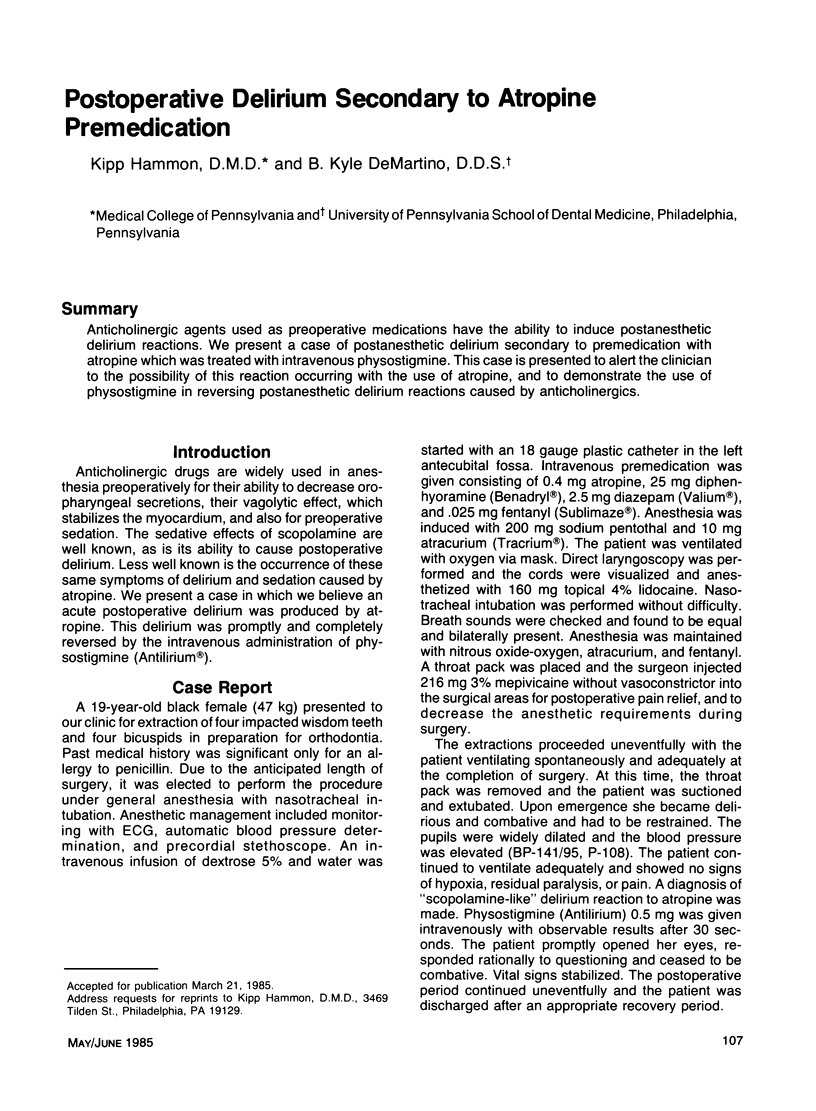Abstract
Anticholinergic agents used as preoperative medications have the ability to induce postanesthetic delirium reactions. We present a case of postanesthetic delirium secondary to premedication with atropine which was treated with intravenous physostigmine. This case is presented to alert the clinician to the possibility of this reaction occurring with the use of atropine, and to demonstrate the use of physostigmine in reversing postanesthetic delirium reactions caused by anticholinergics.
Full text
PDF

Selected References
These references are in PubMed. This may not be the complete list of references from this article.
- Bergman K. R., Pearson C., Waltz G. W., Evans R., 3rd Atropine-induced psychosis. An unusual complication of therapy with inhaled atropine sulfate. Chest. 1980 Dec;78(6):891–893. doi: 10.1378/chest.78.6.891. [DOI] [PubMed] [Google Scholar]
- Crowell E. B., Jr, Ketchum J. S. The treatment of scopolamine-induced delirium with physostigmine. Clin Pharmacol Ther. 1967 May-Jun;8(3):409–414. doi: 10.1002/cpt196783409. [DOI] [PubMed] [Google Scholar]
- Duvoisin R. C., Katz R. Reversal of central anticholinergic syndrome in man by physostigmine. JAMA. 1968 Nov 25;206(9):1963–1965. [PubMed] [Google Scholar]
- Greene L. T. Physostigmine treatment of anticholinergic-drug depression in postoperative patients. Anesth Analg. 1971 Mar-Apr;50(2):222–226. [PubMed] [Google Scholar]
- Heiser J. F., Gillin J. C. The reversal of anticholinergic drug-induced delirium and coma with physostigmine. Am J Psychiatry. 1971 Feb;127(8):1050–1054. doi: 10.1176/ajp.127.8.1050. [DOI] [PubMed] [Google Scholar]
- Holzgrafe R. E., Vondrell J. J., Mintz S. M. Reversal of postoperative reactions to scopolamine with physostigmine. Anesth Analg. 1973 Nov-Dec;52(6):921–925. [PubMed] [Google Scholar]
- Hussey H. H. Editorial: Physostigmine: value in treatment of central toxic effects of anti-cholinergic drugs. JAMA. 1975 Mar 10;231(10):1066–1066. doi: 10.1001/jama.231.10.1066. [DOI] [PubMed] [Google Scholar]
- Kongsrud F., Sponheim S. A comparison of atropine and glycopyrrolate in anaesthetic practice. Acta Anaesthesiol Scand. 1982 Dec;26(6):620–625. doi: 10.1111/j.1399-6576.1982.tb01827.x. [DOI] [PubMed] [Google Scholar]
- Longo V. G. Behavioral and electroencephalographic effects of atropine and related compounds. Pharmacol Rev. 1966 Jun;18(2):965–996. [PubMed] [Google Scholar]
- Smith D. S., Orkin F. K., Gardner S. M., Zakeosian G. Prolonged sedation in the elderly after intraoperative atropine administration. Anesthesiology. 1979 Oct;51(4):348–349. doi: 10.1097/00000542-197910000-00016. [DOI] [PubMed] [Google Scholar]
- Young S. E., Ruiz R. S., Falletta J. Reversal of systemic toxic effects of scopolamine with physostigmine salicylate. Am J Ophthalmol. 1971 Dec;72(6):1136–1138. doi: 10.1016/0002-9394(71)91221-9. [DOI] [PubMed] [Google Scholar]


